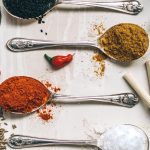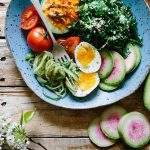The word orange comes from the Sanskrit word nāraṅgaḥ which means ‘orange tree’. Plant origin foods which are coloured orange are usually rich in carotenoid pigments. In some foods like tomatoes and carrots, the carotenoids are present as crystals, while in foods like paprika and mangoes carotenoids can be found dissolved in lipid droplets. This pigment is liposoluble, and is therefore better absorbed and used by the body when taken along with other sources of fat such as nuts and oils.
Carotenoids are very important for their nutritional value and their function as precursors of vitamin A. They can be found in many vegetables and fruits as well as other plant base foods. Once in the body, they are converted into retinol by the liver. On the other hand, we can find vitamin A in the form of retinol in animal food sources such as eggs and liver. About 12mg of beta-carotene or 24 mg of other provitamin A carotenoids are nutritionally equivalent to 1mg of retinol.
Leafy greens contain around 100 to 3,000 retinol equivalents, mostly as beta-carotenes. Carrots, a very classic source, contain 2,000 retinol equivalents for every 100g.
Many epidemiological studies have studied the effects of vegetable and fruit intake over several diseases, where close attention has been focused on beta-carotenes. Among their health benefits it can be highlighted that carotenoids are essential for the health of your eyes, your immune system and for your skin. Let’s look at a few more reasons orange is essential in your diet and how to include it…
Testing Your Vitamin A Levels
If you go to the cinema and you take a long time adjusting to the darkness, this could be a sign that your levels of vitamin A are low. Due to lack of vegetable intake or a poor diet this can actually be very common. A good way to get your diet back on track and prevent diseases is to check if you are eating your rainbow correctly. Below you can check out foods that are rich in colour orange and carotenoids or vitamin A.
The best way to assure that you get the best allowance of beta-carotenes from your food is by including healthy sources of fat in your meal. Vitamin A intake from raw foods commonly has an absorption rate of about 10% — but when you cook your vegetables it can increase the absorption of vitamin A in your body up to 50%, so it’s always a good idea to add some cooked veg to your plate. Include the foods below in your diet to improve the condition of your skin, eye health and boost your immune system:
Orange Fruit and Veg
Carotenoids and vitamin A are most celebrated for their antioxidant properties and for assisting our vision but they’re also required for maintaining healthy mucus and skin. Research has also shown that including fruits and veggies rich in carotenoids can protect you from cancer in the lungs (if you are not a smoker) and oral cavities.
Try replacing potatoes in this weekly shop with sweet potatoes. They’re a better option than potatoes because of — you guessed it! — their extra vitamin A content. Bake them and add salt and pepper to enjoy a healthy portion of yumminess and vitamin A.
Carrots are one of the most classic sources of beta-carotenes. Drink your way to health by adding carrots to your green juice or chop them up and cook them into soups by adding almond milk, cumin, ginger and a touch of olive oil.
Date-plum or lotus persimmons come from the southwest of Asia and the southeast of Europe. It was known to the ancient Greeks as ‘the fruit of the gods’ and its orangey colour is of course due to its carotenoid richness. Persimmons can be eaten fresh, dry, raw, or even cooked. If you eat it fresh, you can bite into it like an apple, cut into quarters, or sliced, though with some astringent and less sweet varieties, it might be best if you peel the skin off first.
Mangoes are one of the foods with the most beta-carotene in tropical countries. It is also rich in flavonoids and contains a wide variety of carotenoids. About 100g of mango will give you 25% of recommended daily levels of vitamin A. Fresh or dry, mangos can be a great snack or part of your salads and yogurt or smoothies.
Other Orange Foods To Consider
Honey is a plant product that is not only a rich source of energy but also of vitamin A which makes it a great healing and protective food. Due to its great nutritional qualities it is also great for the skin. You can even apply it to chapped lips or small cuts. Add a teaspoon of honey to your tea, yogurt or oatmeal to add flavour and nutrition into your day.
In animal tissues, like salmon or liver, the vitamin is always derived from plant sources and is stored and transported as a type of retinol known as retinyl ester which forms part of a fatty acid. Cod and halibut liver oils are well known for their vitamin A content, around 1000000 and 100000000 retinol equivalents for every 100g can be found here.
In eggs, the vitamin A and most of the micronutrients are concentrated in the yolk. Thanks to the vitamin A, protein and B-complex vitamins, eggs can be a great healing food for injuries and an immune system booster. Eat them boiled as practical snacks or mix them with veggies for a heartful breakfast or mid-day brunch. Add some olive oil, butter, coconut oil or your preferred source of fat to make the absorption of vitamin A possible.
See Also: The 12 Best Snacks to Have on Hand in 2016
Vitamin A Precautions
Vitamin A, or retinol, is most widely found in nature in its precursor form in the diet. It is quite safe to consume in this form, however toxicity can occur when you take too many supplements containing retinol in its pure form. Therefore, during pregnancy, it is not recommended to take isolated forms or supplements of vitamin A. Also, due to its liposoluble behaviour, vitamin A, can accumulate in the fatty tissue and liver, which may lead to toxicity. As a result, the best way to obtain vitamin A is from the diet or as its precursor form, widely found in orange-coloured foods.
So adding a bit more orange to your diet can help you obtain your daily requirement of vitamin A and help with healthy skin, stronger vision and boost your immune system. On your next meal, add a little bit of light and colour by including orange-like foods with a source of fat so that they will be absorbed and useful for your body.













